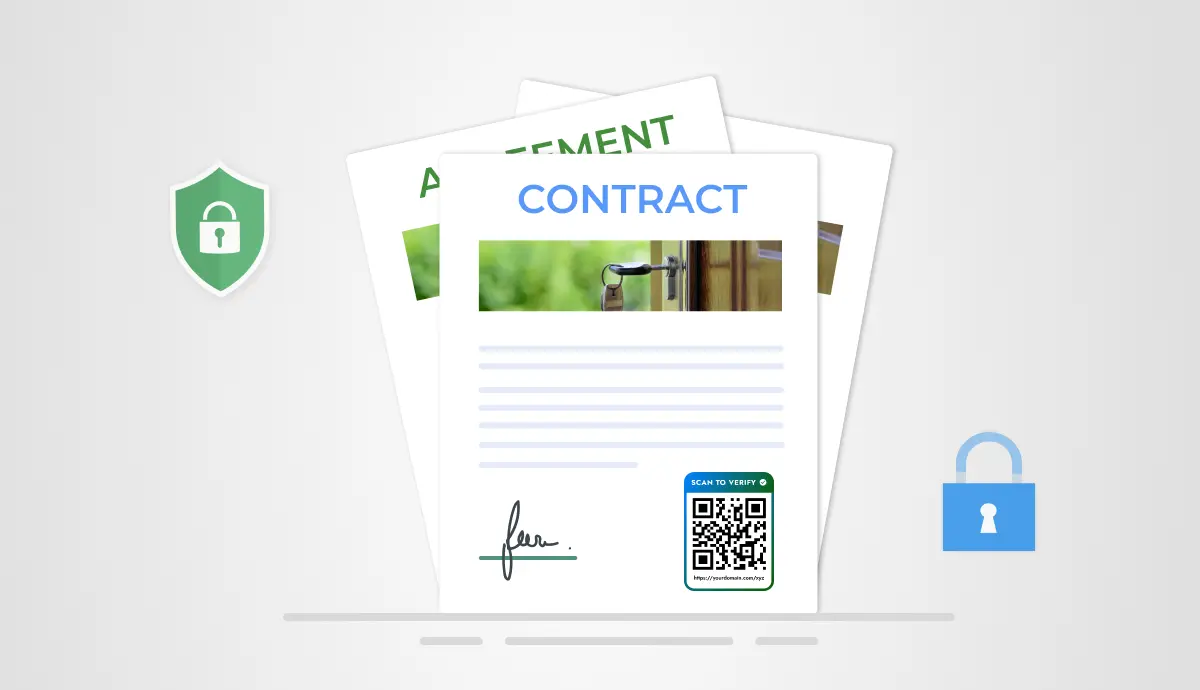Are you concerned about the integrity of the documents you create? Let’s assume you generate an important contract, a legal certificate, or even a simple invoice.
At first glance, everything appears to be in order—correct formatting, official logos, and signatures, but how can you guarantee that your recipients will believe in its validity?
Your document’s trustworthiness is crucial. It affects how others view your work and could potentially impact your business choices.
A Bloomberg article noted that over the past ten years, fake documents have led to a loss of USD 9 billion. This seems a little serious and worrisome. Forged documents can affect anyone, from individuals to large businesses.
A. Are you at risk?
As a potential customer, it’s essential to evaluate your vulnerability to potential dangers of document forgery. It may have significant implications for individuals and businesses. Here’s how you could be at risk:
1. Financial vulnerability
Fraudulent Transactions: Say you’re a business owner. Against every purchase order, you need to raise an invoice for the customers to make payment.
Now, say someone creates fake invoices on your behalf and sends them to your customers. This could lead them to make payments for services that don’t exist. It could possibly damage your relationship with customers.
Identity Theft: Imagine you’re a business owner who has built a loyal client base. Now, scammers could forge documents using your company’s name to steal your clients’ identities, giving them unauthorized access to sensitive information. This identity theft can devastate your clients and damage your reputation.
For instance, Cyber News reported that scammers sent fake invoices from Apple and Amazon via email, causing users to panic and reveal personal information when they called the number listed in the email.
2. Legal exposure
Contractual Obligations: Let’s say you’ve drafted a contract for a significant deal. Now, what if someone forges that document and claims you’ve agreed to terms you never approved?
Suddenly, you could find yourself bound to obligations that aren’t real. This situation could lead to legal disputes and hefty financial penalties.
Regulatory Compliance: If you operate in a regulated industry, such as finance or healthcare, you know how crucial it is to comply with strict guidelines.
Now, consider this—if a healthcare provider uses a fake prescription from your company, you could face penalties for not securing your documents. Regulators expect businesses to have strong processes to verify documents.
3. Reputational damage
Loss of Trust: Trust is the foundation of any successful business relationship.
Now, imagine your clients or partners discover that you’ve issued forged documents. The fallout could be severe, damaging your credibility and making it difficult to regain that trust
Negative Publicity: In today’s digital world, news spreads quickly. If your business is linked to fraud, it can lead to a public relations crisis that takes years to resolve.
Imagine if a fake document from your company is used in a big scam. The media might report on it, damaging your company’s name. Negative publicity can scare away customers and make it harder to attract customers.
4. Operational disruptions
Increased Scrutiny: Think about the implications of your documents being linked to fraudulent activities. You might find yourself under increased scrutiny from regulators and customers.
This can disrupt your operations and slow down your business growth, making it challenging to focus on what you do best
Resource Drain: Consider the toll that legal battles, investigations, and remediation efforts can take on your business.
Dealing with these issues can divert valuable time and resources away from your core activities. Instead of focusing on growth and innovation, you could be stuck managing the fallout from fraud-related incidents.
B. Quick methods to secure documents
1. Watermarks
Watermarking is a way to add a visible image or text to a document. Many official documents, certificates, and currencies use watermarks as a security feature.
Watermarks come in different forms such as logos, patterns, or text. Watermarks are usually hard to copy. However, with modern AI-technology, some counterfeiters now use sophisticated software to remove or alter watermarks easily

(Source: YouTube)
2. Hologram
Holograms use laser technology to create 3D images. They’re hard to fake because they change when viewed from different angles.
Many official documents use custom holograms where they show logos or complex patterns. However, they are expensive to make since they require special equipment, which may not be feasible for all types of documents.

(Source: Made-in-China)
3. Specialized paper
These type papers, popularly known as anti-counterfeit papers, contain unique elements like colored fibers and chemical treatments. These elements are hard to duplicate without the exact materials and manufacturing process.
However, specialized paper costs much more than regular paper. Using it for high-volume documents like invoices or shipping labels would significantly increase operating costs.
4. Sealed envelope
These sealed envelopes are used to protect the documents during transit and storage and possess the tendency to show clear signs if someone tries to open them.
They often have unique adhesives or tear-away strips that leave visible marks when tampered with. Applying tamper-evident seals takes time and adds steps to document processing. This can be inconvenient and costly, especially for documents that need frequent access.

(Source: Adobe Firefly)
5. QR Codes
QR Codes are advanced barcodes that can be scanned with a smartphone camera. They can be used to encode information or link to a secure website.
They can also include verification data, ensuring that the document is authentic and has not been altered. This is by far one of the most secure and easy methods to secure documents.
QR Codes stand out as the top choice for document security, outperforming traditional methods such as watermarks, holograms, specialized paper, and sealed envelopes. They’re easy to create, cost-effective, and highly versatile.
C. Role of QR Codes in modern security solutions
1. Better document verification
QR Codes act as a link between paper documents and digital domains.
Companies can show that their documents are real and safe by using a unique QR Code tied to a trusted domain. When someone scans the QR Code, it takes them to a secure page on the brand or institution’s domain.
This secure page displays the name of the issuing authority or institution and the date the document was issued. Users can download the original document directly from the secure page, which allows them to confirm that the document is authentic and up-to-date.
2. Counterfeit prevention
QR Codes are difficult to replicate precisely since they are linked to a specific domain. For instance, a QR Code could lead to a secure server that is managed by the issuing authority.
This makes it tough for counterfeiters to pass checks. They can’t copy the secure website or trick the secure backend verification system
3. Easy user experience
QR Codes are simple to use. Users can scan them with their smartphones without using special apps. Ease of use is key to getting more people to adopt the technology. Plus, a custom URL makes it clear what users are accessing, which encourages them to engage.
D. Secure documents easily using QR Codes
Now you know that you need to secure your original documents. To actually do that, you need a document verification solution to get started—especially the one that uses QR Codes. There are a few good cloud-based SaaS applications out there. For a demo on how to use one, we’ll explore QR Mark.
QR Mark is a platform designed to protect original documents from being forged. It uses unique QR Codes and branded links to authenticate documents. In addition, QR Mark is in its beta phase and free to use.
E. How to secure documents using QR Mark?
1. Addition of custom domain
Set up and use a domain or subdomain for all your verification links. This helps build trust with the people who receive your documents.
2. Upload or add your document
Either upload your document in PDF format or directly use the QR Mark add-ons such as Google Docs and Microsoft 365.
3. Generate verification image
Add a verification image that has a secure QR Code and a verification link. You can move and resize it to fit your document.
4. Download and share
Your document is now secure. Download it with a simple click and share it with others. People can scan the QR Code to check if your document is real.
F. Why use QR Mark for securing documents
1. Document protection
QR Mark helps safeguard important documents with unique QR Codes and verification links in each document. This ensures that anyone who receives the document can easily check its authenticity.
2. Secure sharing
With QR Mark, sharing documents becomes easy and secure. When a business sends a document, the recipient can quickly verify its authenticity by scanning the QR Code. This feature helps eliminate doubts and confusion about the document’s validity.
3. User-friendly platform
QR Mark offers a simple and user-friendly platform for businesses. Users can create and manage documents easily by adding QR Codes and verification links without hassle.
G. Conclusion
QR Codes offer a simple and effective way to verify the authenticity of documents. In a world where forged documents can lead to significant financial losses and legal troubles, using QR Codes can help eliminate these risks.
By linking documents to secure websites, QR Codes allow users to quickly check if a document is real. This process is straightforward and user-friendly, making it accessible for everyone.
Furthermore, platforms like QR Mark make it even easier to implement this technology.
By allowing users to create and manage documents with unique QR Codes, businesses can protect themselves and their clients from the dangers of document forgery.


Leave a Reply